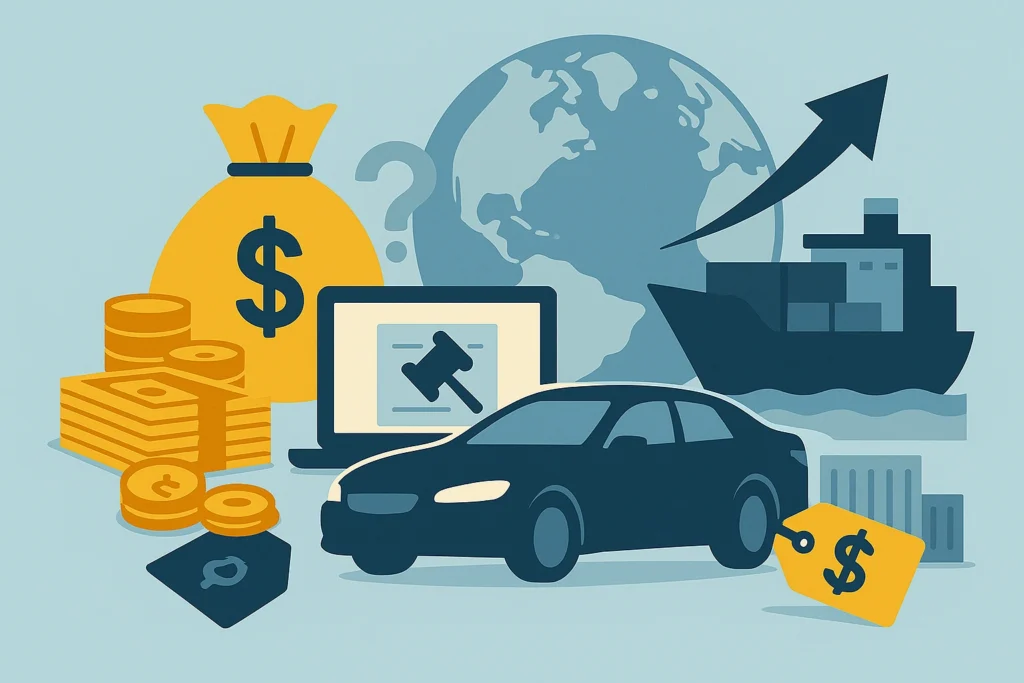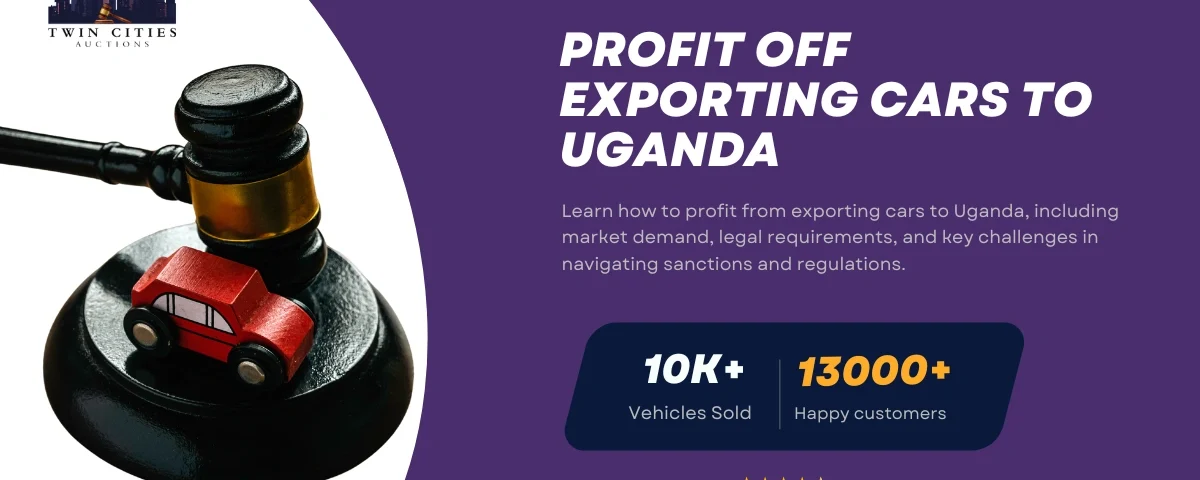Did you know Uganda imported an estimated 12 000 to 15 000 motor vehicles in 2023, valued at 70 million to 85 million US dollars and growing at around 9 percent annually?
US exporters tapping this demand have increased profit margins by up to 18 percent within six months. This guide shows you how to comply with Uganda’s import rules, calculate costs, and organize logistics for maximum returns.

Key Takeaways
- Uganda imported approximately 12 000–15 000 vehicles in 2023¹
- Import costs add about 44 percent of vehicle value²
- Profit equals landed cost plus your margin
- Main entry points are Port Bell via Mombasa Road Corridor³
- Required documents: invoice, bill of lading, import permit, certificate of conformity⁴
- Best sourcing option is U S auto auctions
Understanding the Ugandan Market
Uganda’s vehicle import market has been experiencing steady growth. In 2023, the country imported an estimated 12,000–15,000 motor vehicles, valued between $70 million and $85 million.
Urban consumers, particularly in Kampala, show a preference for fuel-efficient sedans and compact SUVs, while diesel pickups are favored in commercial and rural sectors. This trend reflects the diverse transportation needs across different regions of Uganda.
| Metric | Estimated Figure |
| Vehicles Imported | 12 000–15 000 units |
| Market Value | 70 million–85 million USD |
| Year‑over‑Year Growth | ~9 percent |
Source: Uganda Bureau of Statistics
Regulations and Compliance
Uganda enforces specific regulations to control the quality and environmental impact of imported vehicles. As of 2018, the country implemented a ban on the importation of vehicles older than 15 years from the date of manufacture.
This policy aims to reduce environmental pollution and improve road safety by ensuring newer, more efficient vehicles are on the roads. Additionally, all imported vehicles must obtain a Certificate of Conformity (CoC) from accredited inspection centers, verifying compliance with safety and emission standards.
| Document | Purpose | Required For |
| Commercial Invoice | Declares sale value | All imports |
| Bill of Lading | Proof of maritime shipment | Sea‑borne imports |
| Import Permit | Government authorization | All motor vehicle imports |
| Certificate of Conformity | Verifies safety and emissions compliance | All imports |
Source: Uganda Revenue Authority
Building Your Landed Cost and Profit Model
Calculate landed cost by summing CIF cost, import duty, VAT, and fees. Then add your profit margin.
| Cost Item | Rate | Calculation Example (USD) |
| CIF Cost | — | 10 000 |
| Import Duty | 27 percent | 2 700 |
| Value Added Tax | 18 percent | (10 000 + 2 700) × 0.18 = 2 394 |
| Miscellaneous Fees | 5 percent | 10 000 × 0.05 = 500 |
| Total Landed | — | 15 594 |
Source: Uganda Revenue Authority
Logistics and Shipping Routes
Being a landlocked country, Uganda relies heavily on the Port of Mombasa in Kenya for its imports. From Mombasa, goods are transported inland via the Northern Corridor, a key trade route that includes road and rail networks, to reach Kampala and other parts of Uganda.
This corridor is managed by the Northern Corridor Transit and Transport Coordination Authority (NCTTCA), which coordinates infrastructure improvements and facilitates trade among member countries.
| Route | Transit Time | Notes |
| U S East Coast → Mombasa → Kampala (Port Bell) | 30–35 days | Suez Canal + inland trucking |
| U S Gulf Coast → Mombasa → Kampala (Port Bell) | 28–32 days | Red Sea route + Northern Corridor road haul |
| U S West Coast → Mombasa → Kampala (Port Bell) | 35–40 days | Panama + Suez transit + road transport |
Source: Bolloré Logistics & Maersk
Financing and Payment Security
Importers have several financing options to facilitate vehicle purchases. One notable partnership is between Stanbic Bank Uganda and Autochek, which offers affordable vehicle financing solutions tailored for local businesses and individual buyers.
These financing options aim to make vehicle ownership more accessible and support the growth of the automotive sector in Uganda.
| Method | Risk Level | Best Use |
| Letter of Credit | Low | First shipments and large orders |
| Open Account | High | Established, trusted buyers |
| Escrow | Medium | Ensures delivery before payment release |
Source: U S Export‑Import Bank
Mitigate currency fluctuations with USD to UGX forward contracts through major Ugandan banks.
Common Pitfalls to Avoid
- Underestimating combined duty and VAT erodes margins
- Missing import permit or Certificate of Conformity delays clearance
- Relying on outdated age‑limit rules leads to rejections
Use the URA pre‑shipment checklist to confirm documentation.
Source: Uganda Revenue Authority
Why Auctions Are a Smart Choice for Car Purchases
Auctions can be an excellent source for late-model vehicles with clear chains of title and affordable pricing. Twin Cities Auctions, based in Minnesota, is one such reputable auction house that offers a wide range of vehicles at competitive prices.
Key Benefits of Buying from Auctions:
- Wide Selection: Auctions like Twin Cities Auctions offer a variety of vehicles, from low-budget cars to high-end models.

- Competitive Pricing: Auctions often offer vehicles at prices below retail value, enabling dealers to maximize their profit margins.

- Transparency: Auctions provide full vehicle history reports, so you know exactly what you’re buying.

- Convenient Bidding: Many auctions offer online bidding for your convenience, making it easier to source vehicles without being physically present.
Twin Cities Auctions: A Smart Vehicle Sourcing Choice
For those in the automotive industry, Twin Cities Auctions offers an excellent platform for sourcing quality vehicles at competitive prices.
Whether you are just starting or expanding your business, this auction house provides transparency, competitive pricing, and a broad selection.
| Feature | Description |
| Inventory Variety | Wide range of cars, trucks, and SUVs available |
| Competitive Pricing | Below-market pricing allows for higher profit margins |
| Vehicle History Reports | Detailed history reports for every vehicle |
| Online Bidding | Convenient online bidding options for dealers |
| Financing Options | Financing available to help with inventory purchases |
Conclusion
By following Uganda’s import rules—respecting the ten-year age limit, securing a Certificate of Conformity and import permit, and accurately calculating landed cost—you’ll safeguard your margins and avoid costly delays.
Leveraging reliable routes through Mombasa and Port Bell, pairing sound financing (letters of credit or forward contracts) with USD/UGX hedging, and sourcing late-model vehicles from U S auto auctions like Twin Cities Auctions will streamline your operations.
Armed with this guide, you’re well positioned to convert Uganda’s 9 percent annual growth and 12 000–15 000-unit demand into sustainable profits of up to 18 percent.
Find Your Next Ride Online at Twin Cities Auctions—No Dealer License Required
Searching for your next vehicle? Twin Cities Auctions offers an online, transparent car auction experience that’s accessible to everyone, no dealer license needed. Browse and bid on a diverse selection of quality vehicles from the comfort of your home.
Whether you’re a first-time buyer or an experienced trader, our clear, honest bidding process ensures you can make informed decisions in a supportive environment. Join our next online auction and discover how effortless and enjoyable finding your next car can be with Twin Cities Auctions!
Looking for more options? Explore our comprehensive list of all available car auctions across the United States. Your next deal might be just a click away!
FAQ
What are Uganda’s auto import duties?
Import duty is 27 percent of CIF value plus VAT of 18 percent.
Can I export used cars to Uganda?
Yes—vehicles must be no older than ten years and hold a Certificate of Conformity.
What age restrictions apply?
Imports must be manufactured within the last ten years.
How long does customs clearance take?
Typically 7–10 business days once all documents are complete.
Are emissions tests mandatory?
Yes—Certificate of Conformity must verify compliance with national emissions standards.


